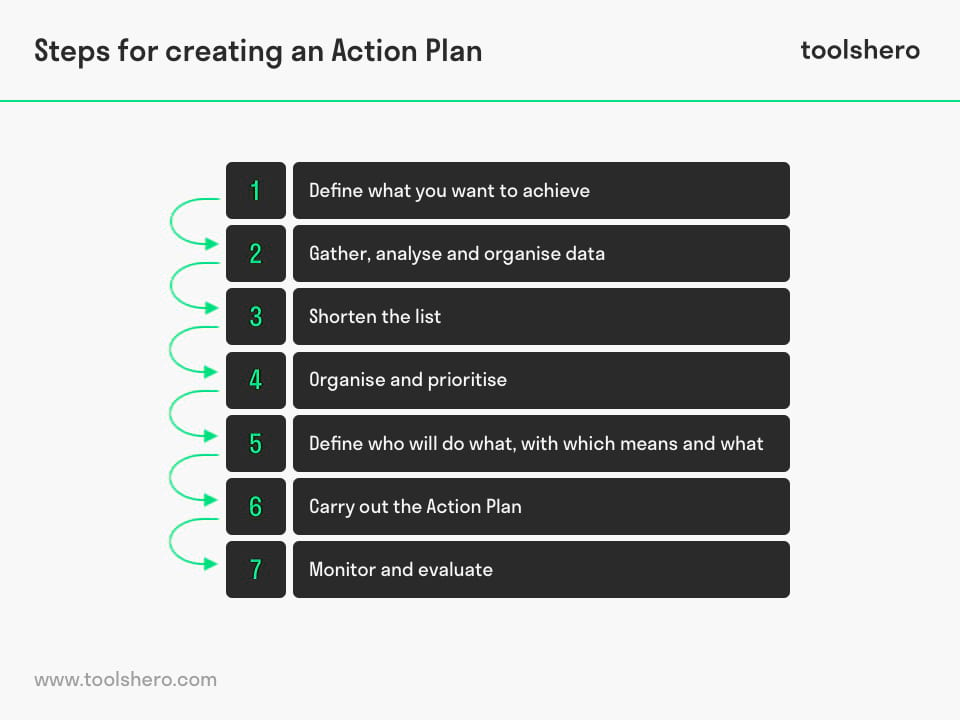Action Plan explained plus template

Action Plan: this article explains the concept of an Action Plan in a practical way. It covers what an Action Plan is, explains the steps that need to be taken, along with an example, and provides some tips. It also contains a downloadable and editable Action Plan template. After reading this article, you will understand the basics of this effectiveness and time management tool. Enjoy reading!
What is an Action Plan?
The definition of a Action Plan
An Action Plan or Action Programme can be defined as a detailed plan with specified actions that are needed to achieve a goal. It can also consist of a series of steps that must be taken to successfully complete a certain strategy.
Furthermore, an action programme determines which resources are required to achieve (SMART Goals) and how and when these must be used. That means that it leads to a more concrete vision or objective for an organisation. The advantage is that the various parties working on a strategy are on the same page.
An Action Plan is an expansion of the well-known ‘to-do list’. It is generally acknowledged that these lists can be useful; many people use them in their daily lives.
However, the disadvantage of such lists consisting entirely of tasks is that these are often considered to be overwhelming when a person, such as a project manager, bears multiple responsibilities.
An Action Plan is a stronger version of such a to-do list, that includes objectives for the short, medium and long term. This makes it easier to delegate certain tasks and helps to save time, in order to achieve the planned goals.
Additionally, an action programme encourages prioritising and focusing on the important matters.
This too can help to save valuable time which increases the effectiveness and productivity of a company or individual employee. What was previously experienced as overwhelming now becomes insightful and controlled.
Action Plan example and steps
In order to write an action plan, the following steps (step by step), guided by an example are advised to follow for setting up.
Example and scenario: coffee shop ABCoffee wishes to start importing its coffee from Colombia itself rather than purchasing from an import business because the purchase costs are too high to make sufficient profit.

Figure 1 – The seven steps of creating a successful Action Plan
1. Define what you want to achieve
Composing the goal is crucial for motivation and reminds the user of the fact that the eventual result is worth the effort.
This could comprise the solution to a problem, to be established with the Problem Definition Process, or interim objectives in a project.
Scenario ABCoffee: ABCoffee’s current purchasing policy isn’t viable due to the high purchase price. If ABCoffee were to import its own coffee, this could lead to a saving on purchasing costs of 15%. The lower purchasing costs are incorporated into the sales price to guarantee sufficient customers.
2. Gather, analyse and organise data
Make a list with all the issues that demand a solution within the problem definition or interim goals.
Try to gather everything that is relevant and that you believe requires action to complete the Action Plan, large or small, personal or professional. Also consider the things that are automatically gathered such as relevant e-mails or documents in the archives.
Also write down all the ideas that are floating around in your head and gather ideas you’ve written down on a piece of paper that you keep in the bottom of your drawer.
Take stock of these ideas in a single place; this is needed to create focus and to set-up the planning process. This also includes the to-do lists.
Scenario:
- Contacting coffee farmers in Colombia
- Requesting quotations
- Trip to Colombia to inspect and establish the quality of the coffee beans
- Price negotiations
3. Shorten the list
Now that you have a list containing everything that is related to the completion of the Action Plan, this list needs to be shortened.
Scenario ABCoffee: due to the already limited financial means, the manager of ABCoffee decides against inspecting the quality of the coffee during a trip to Colombia. Instead, he asks that samples of the coffee are mailed to him.
4. Organise and prioritise
Take stock of which actions or projects take priority (in combination with due dates) and make two lists of actions.
Individual or smaller tasks and actions that are part of a greater whole and that may require multiple people for execution and to assign tasks.
Use the Action Priorities Matrix (APM) to effectively prioritise and create an overview of roles and responsibilities of the stakeholders and team members.
Scenario ABCoffee: use the APM to prioritise. In this case, the actions from step 3 are already in the correct order.
5. Define who will do what, with which means and when
When arriving at this point, the task step, the main part of the Action Plan has already been completed.
Now take the list with actions to be completed and assign the actions to a person. Take everyone’s competences into account to ensure effective completion. Also consider:
- Who is responsible for what (use the Responsibility Assignment Matrix for this purpose)
- Who and what needs support
- Communication methods
Scenario ABCoffee: in the case of a new purchase strategy of ABCoffee, the sales manager, due to the absence of a purchase manager, is responsible for the entire process.
6. Carry out the Action Plan
Give the starting signal for the Action Plan. Keep the 80-20 rule (Pareto Analysis) in mind: focus on what’s important.
Also monitor progress, deadlines and milestone. Use the Gantt Chart for this purpose.
7. Monitor and evaluate
During the execution, it’s essential to carefully and effectively monitor the goings-on. When changes or new problems come to light, these must be communicated to everyone in order to prevent unnecessary work. Ask yourself the following questions:
- Are we doing what was agreed upon?
- Are we doing it correctly?
- Is what we’re doing important for the goal?
- Have all individual and group actions been completed?
- Has the final goal been achieved?
Tips for Creating an Action Plan
The following tips help you to effectively create a clear Action Plan:
- Use all tools that are offered in this article
- Choose and define a suitable goal
- Write down the actions to be taken in a concrete, measurable and achievable form
- Communicate with everyone who’s involved in the execution of the action programme
Action Plan template
Use this simple action plan template as a helpful tool to specify the actions needed to complete a certain strategy. Available as an editable template.
Download the Action Plan template
This template is exclusively for our paying Toolshero members. Click here to see if a membership is something for you!Now It’s Your Turn
What do you think? Do you recognise the explanation of the Action Plan? What do you believe are factors that contribute to the effective achieving of goals or solving of problems? How do you use action programmes? Do you have any tips or additional comments?
Share your experience and knowledge in the comments box below.
More information
- Goodstein, L., Nolan, T., Pfeiffer, J. (1993). Applied Strategic Planning: How to Develop a Plan That Really Works. McGraw-Hill Education.
- Kerzner, H., & Kerzner, H. R. (2017). Project management: a systems approach to planning, scheduling, and controlling. John Wiley & Sons.
- Macan, T. H. (1994). Time management: Test of a process model. Journal of applied psychology, 79(3), 381.
How to cite this article:
Janse, B. (2018). Action Plan. Retrieved [insert date] from Toolshero: https://www.toolshero.com/personal-development/action-plan/
Original publication date: 12/18/2018 | Last update: 12/24/2023
Add a link to this page on your website:
<a href=”https://www.toolshero.com/personal-development/action-plan/”>Toolshero: Action Plan</a>












